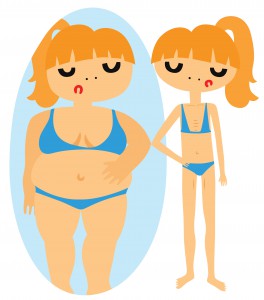
Living with diabetes and the constant need to monitor your blood sugar and carb intake can create a complicated relationship with food. For some, the combination of body image issues mixed with depression and anxiety from diabetes burnout can lead to the development of an eating disorder. This complex cycle of negative body images, the stigma of having diabetes, and carb restriction can create a very challenging and dangerous situation for people with diabetes – both for their emotional and physical well-being.
Eating disorders in persons with diabetes are most commonly found in teens and young women with type 1 diabetes who develop “diabulimia” – diabetes and bulimia. Bulimia is the recurrent eating of large quantities of food and then purging – either through vomiting, laxative use or excessive amounts of exercise. People with diabetes and bulimia also reduce or completely stop using insulin to lose calories and glucose through the urine. This causes extremely high blood sugars and can lead to diabetic ketoacidosis and coma. Some may refrain from treating a hypo because they do not want to consume the extra calories.[1]
Anorexia and Binge Eating Disorder are other common eating disorders. Anorexia is defined as severe calorie restriction and weight lose by self-induced starvation. Binge Eating Disorder is more prevalent in women with type 2 diabetes. People with this condition often overeat impulsively to the point of being uncomfortably full and without purging.[2] Overtime the risk for earlier onset of diabetes complications such as eye and kidney disease increases.
The warning signs of an eating disorders in diabetes include:
- Increases in A1C values that cannot be explained
- Multiple episodes of diabetic ketoacidosis (DKA)
- Obsessive thoughts about weight
- Overly intense exercise routines (sometimes accompanied by frequent hypos)
- Amenorrhea (missing a monthly menstrual cycle).[3]
One leading influence in the development of eating disorders like anorexia and bulimia for the general population is the constant barrage of unrealistic standards of beauty portrayed and edited with Photoshop in popular culture. Such societal pressure can push a desire to be thin to an obsessive point. Myths in the media about people with diabetes being overweight and being to blame for their condition can make people feel ashamed and push people to the brink of engaging in harmful behavior to be thin.
In diabetes treatment, there is a lot of emphasis on the word control. Control your blood sugars. Control your carbs. Control your weight. Control your body. Constantly being told to be in control of a chronic disease like diabetes can actually make you feel out of control, leading to feelings of depression and anxiety when you don’t meet your compliance goals. People can develop negative coping mechanisms to redirect the control over their diabetes – like an eating disorder where they are over controlling their food intake. Experts claim the recommended attention to diet, blood sugar, weight, and exercise as part of a standard treatment recommendation for diabetes is comparable to the rigid thinking about food and body image that is found in people who have eating disorders but not diabetes.[4]
Relinquish the idea of complete control and focus on managing your diabetes. Don’t be so hard on yourself. You cannot control how every little part of your daily diabetes life will affect you. Using a Diabetes Management Solution like Dario can help to better handle diabetes and give you data to make better informed decisions in your diabetes care. You can still have goals for weight loss and carb intake, but be sure to set healthy boundaries. Keep body positive and accept your body for everything that it is and isn’t. If think that you or someone you love may have an eating disorder it is important to seek help from your medical team.
[1] https://static.diabetesaustralia.com.au/s/fileassets/diabetes-australia/bd9877a3-3289-43d9-a2ee-7598b4d1f1ca.pdf
[2] http://www.diabetes.org/living-with-diabetes/treatment-and-care/women/eating-disorders.html
[3] http://www.joslin.org/info/Eating_Disorders_Diabulimia_in_Type_1_Diabetes.html




